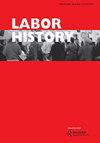巨大的斗争:1937-1945年静坐罢工后建立美国汽车工人联合会的斗争
IF 0.7
4区 管理学
Q1 HISTORY
引用次数: 0
摘要
本文考察了1936年至1937年密歇根州弗林特市静坐罢工后几年建立美国汽车工人联合会的斗争。这场被历史学家费恩(Sidney Fine)称为“20世纪美国最重大的劳资冲突”的罢工吸引了大量学术关注。虽然这很重要,但要使UAW成为一个代表几乎所有美国汽车工人的机构,还有很多工作要做。罢工发生时,通用汽车在弗林特的47,000名工人中只有10%属于UAW,而该行业的大部分工人都没有组织起来。这篇文章改变了焦点,考察了罢工后建立工会的斗争。在这一时期,工会面临着严重的内部分歧、持续的企业反对、参差不齐的会员水平和经济不稳定。它努力建立自己的地位,内部记录——尤其是被忽视的执行董事会会议记录——显示出相当大的脆弱性和不稳定性。尽管联合汽车工人联合会在1937年至1941年间取得了进展,但在有利的谈判条件下,它在第二次世界大战期间才在全国范围内巩固了自己的地位。即使在那时,它也面临着持续的领导层分歧和普通民众的不满。建立欧盟需要时间,值得更仔细地审视。本文章由计算机程序翻译,如有差异,请以英文原文为准。
Gigantic struggles: the battle to build the United Automobile Workers after the sit-down strikes, 1937–1945
This article examines the struggle to build the United Automobile Workers in the years after the sit-down strike of 1936–37 in Flint, Michigan. The strike, which historian Sidney Fine has called ‘the most significant American labor conflict in the twentieth century,’ has secured the lion’s share of scholarly attention. While it was very important, much remained to be done to make the UAW an institution that represented almost all American autoworkers. At the time of the strike, only 10 percent of GM’s 47,000 Flint workers belonged to the UAW, while much of the industry was unorganized. This article changes the focus, examining the struggle to build the union after the strike. In this period, the union faced bitter internal divisions, ongoing corporate opposition, patchy membership levels, and economic instability. It struggled to establish itself, and internal records – especially overlooked executive board minutes that are mined here – reveal considerable vulnerability and instability. While the UAW made progress between 1937 and 1941, it was in World War II that it solidified itself nationally, helped by favorable bargaining conditions. Even then, it faced ongoing leadership divisions and rank and file disaffection. Building the union took time and deserves closer interrogation.
求助全文
通过发布文献求助,成功后即可免费获取论文全文。
去求助
来源期刊

Labor History
Multiple-
CiteScore
1.00
自引率
28.60%
发文量
44
期刊介绍:
Labor History is the pre-eminent journal for historical scholarship on labor. It is thoroughly ecumenical in its approach and showcases the work of labor historians, industrial relations scholars, labor economists, political scientists, sociologists, social movement theorists, business scholars and all others who write about labor issues. Labor History is also committed to geographical and chronological breadth. It publishes work on labor in the US and all other areas of the world. It is concerned with questions of labor in every time period, from the eighteenth century to contemporary events. Labor History provides a forum for all labor scholars, thus helping to bind together a large but fragmented area of study. By embracing all disciplines, time frames and locales, Labor History is the flagship journal of the entire field. All research articles published in the journal have undergone rigorous peer review, based on initial editor screening and refereeing by at least two anonymous referees.
 求助内容:
求助内容: 应助结果提醒方式:
应助结果提醒方式:


